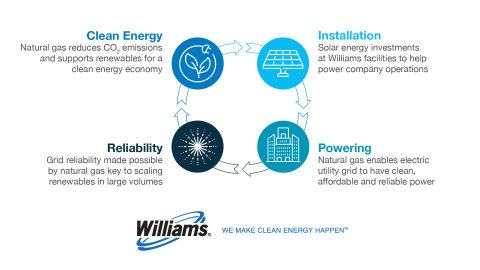Williams Announces Plans to Develop Solar Power at Key Facilities
Williams (NYSE: WMB) today announced that it is taking steps to develop solar energy installations at its facilities to provide electricity to the company’s existing natural gas transmission and processing operations, an investment made possible through generous federal and state tax credits. The move builds on the company’s natural gas-focused strategy, with natural gas generation bringing reliability to the electric power grid and allowing for growth in renewable energy.
This press release features multimedia. View the full release here: https://www.businesswire.com/news/home/20200528005270/en/

Natural gas and renewables are complementary energy sources as illustrated by this graphic.(Photo: Business Wire)
“This initiative demonstrates our ability to leverage Williams’ core business to create complementary renewable energy investment opportunities that provide attractive shareholder returns while preserving the environment for future generations,” said Alan Armstrong, Williams President and CEO. “Natural gas is key to our country’s ability to add more renewable energy to the power grid in large volumes; it is a clean, affordable fuel that can quickly provide power when renewable energy sources are producing less due to the variability of sunlight and wind.”
Williams has been identifying locations where solar power installations are both economic and can be primarily sited on company-owned land that is adjacent to existing facilities. Sites under consideration span Williams’ footprint, with initial sites identified in Alabama, Colorado, Georgia, Louisiana, New Jersey, North Carolina, Ohio, Pennsylvania and Virginia. These facilities are expected to be placed into service beginning late 2021. In total, Williams’ facilities currently draw an average of over 400 megawatts of electricity, purchased from the grid. Williams anticipates that agreements with local utilities will allow excess solar power not used by existing facilities to be sold back into the grid.
“Given the current market structures and tax incentives, we are able to make these attractive incremental investments while continuing to enjoy the reliability that the grid provides via natural gas fired power generation,” said Armstrong. “In addition, solar installations at self-consuming industrial sites like this make more sense because there is less incremental land use and less power transmission voltage losses.”
Click here for more information about Williams’ solar initiative.
About Williams
Williams (NYSE: WMB) is committed to being the leader in providing infrastructure that safely delivers natural gas products to reliably fuel the clean energy economy. Headquartered in Tulsa, Oklahoma, Williams is an industry-leading, investment grade C-Corp with operations across the natural gas value chain including gathering, processing, interstate transportation and storage of natural gas and natural gas liquids. With major positions in top U.S. supply basins, Williams connects the best supplies with the growing demand for clean energy. Williams owns and operates more than 30,000 miles of pipelines system wide – including Transco, the nation’s largest volume and fastest growing pipeline – and handles approximately 30 percent of the natural gas in the United States that is used every day for clean-power generation, heating and industrial use. www.williams.com
Portions of this document may constitute “forward-looking statements” as defined by federal law. Although the company believes any such statements are based on reasonable assumptions, there is no assurance that actual outcomes will not be materially different. Any such statements are made in reliance on the “safe harbor” protections provided under the Private Securities Reform Act of 1995. Additional information about issues that could lead to material changes in performance is contained in the company’s annual and quarterly reports filed with the Securities and Exchange Commission.
View source version on businesswire.com: https://www.businesswire.com/news/home/20200528005270/en/




